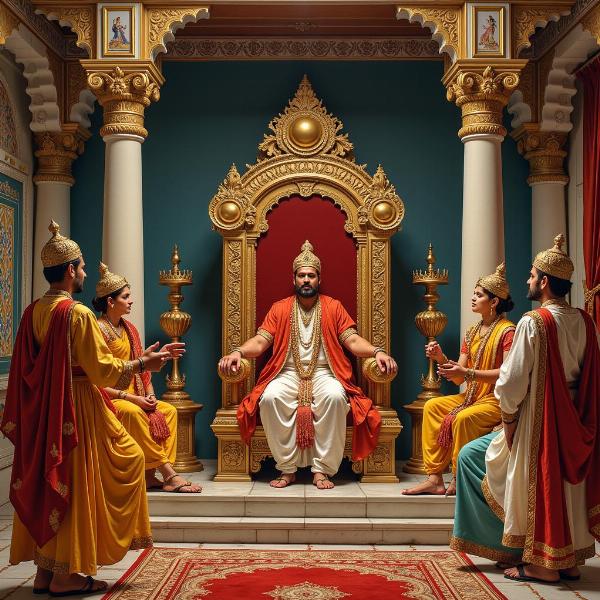Understanding the meaning of “monarchy” is crucial for anyone interested in Indian history, politics, and culture. Monarchy, a system of government where a single person reigns, is a concept with deep roots in India’s past and continues to hold relevance in the modern world. This article explores the various facets of monarchy, its Hindi translations, related terms, and its significance in the Indian context.
Exploring the Hindi Translations of Monarchy
The most common Hindi translation for “monarchy” is “राजतंत्र” (rājatantra). This word is a combination of “राज” (rāj), meaning “rule” or “kingdom,” and “तंत्र” (tantra), meaning “system” or “doctrine.” Therefore, “राजतंत्र” literally translates to “system of rule by a king.” Other terms used to denote monarchy include “एकतंत्र” (ektantra), meaning “rule by one,” and “राजाशाही” (rājāshāhī), which refers to “kingship” or “the rule of a king.” Each term offers slightly different nuances, reflecting the complexities of this form of government.
 Monarchy in Indian History
Monarchy in Indian History
Delving into the Characteristics of a Monarchy
Monarchs typically inherit their position, with succession often determined by lineage. This hereditary aspect is a defining feature, differentiating it from other forms of government. The monarch’s power can range from absolute, where they hold complete control, to constitutional, where their authority is limited by a constitution. Historically, India has witnessed various forms of monarchy, from powerful empires to smaller princely states.
Monarchy vs. Other Forms of Government
Monarchy differs significantly from democracy, where power resides with the people, and republic, where the head of state is elected. In a monarchy, the ruler’s authority is often seen as divinely ordained or based on tradition. This contrasts with the principles of popular sovereignty found in democratic systems. Understanding these distinctions is crucial for analyzing the evolution of governance throughout history.
The Historical Significance of Monarchy in India
India’s history is replete with examples of powerful monarchies, including the Mauryas, Guptas, and Mughals. These empires shaped the cultural, political, and social landscape of the subcontinent. The legacy of these kingdoms can still be seen in India’s architecture, art, and literature. Studying these historical periods offers valuable insights into the impact of monarchy on the nation’s development.
Monarchy in Modern India: A Look at Princely States
Even after independence, several princely states continued to exist within India. While their power was significantly reduced, they played a role in the country’s transition to a republic. The integration of these states into the Indian Union is a significant chapter in the nation’s history.
Frequently Asked Questions (FAQ)
- What is the literal meaning of “राजतंत्र”? The literal meaning of “राजतंत्र” (rājatantra) is “system of rule by a king.”
- What are some examples of famous monarchies in India? The Mauryan Empire, Gupta Empire, and Mughal Empire are notable examples.
- What is the difference between a monarchy and a democracy? In a monarchy, a single person rules, often through hereditary right, while in a democracy, power resides with the people.
- Is there still a monarchy in India today? No, India is a republic. The former princely states were integrated into the Indian Union.
- Why is understanding monarchy important for Indian history? Understanding monarchy is crucial for comprehending India’s political and cultural development over centuries.
- Are there different types of monarchies? Yes, monarchies can range from absolute to constitutional, where the monarch’s power is limited by a constitution.
- What is the role of succession in a monarchy? Succession determines how the next monarch is chosen, often based on lineage or hereditary rules.
Exploring Related Concepts: Vive, Throne, Princely, and Monocracy
To further enrich your understanding, explore the meaning of related terms like vive meaning in hindi (a cheer for the monarch), meaning of throne in hindi (the symbol of royal authority), princely meaning in hindi (relating to princes and royalty), and monocracy meaning in hindi (rule by a single individual). These terms offer valuable insights into the nuances of monarchy and its associated concepts. For those interested in Manipuri royalty, understanding ningthou meaning in hindi can also be beneficial.
Conclusion
In conclusion, understanding the meaning of monarchy in Hindi, its historical significance, and its various facets is crucial for anyone interested in Indian history and culture. From the ancient empires to the princely states, monarchy has played a significant role in shaping India’s identity. This article provides a comprehensive overview of “what is the meaning of monarchy in hindi” and its associated concepts, offering a valuable resource for students, researchers, and anyone seeking a deeper understanding of this important concept.
Meaning-Hindi.in is your trusted partner for accurate and culturally sensitive Hindi translation services. We specialize in various areas, including business, legal, technical, website localization, and academic translations. Our expertise ensures that your documents are translated with precision and respect for the nuances of the Hindi language. Contact us today for all your Hindi translation needs at [email protected] or call us at +91 11-4502-7584. Meaning-Hindi.in is committed to bridging language barriers and fostering clear communication.